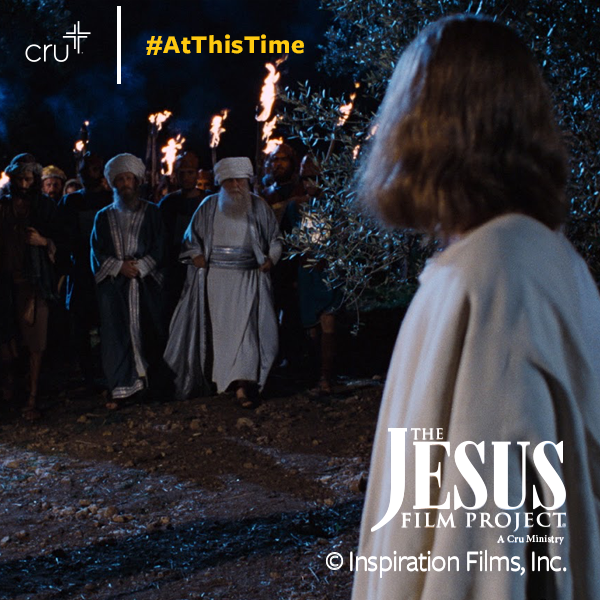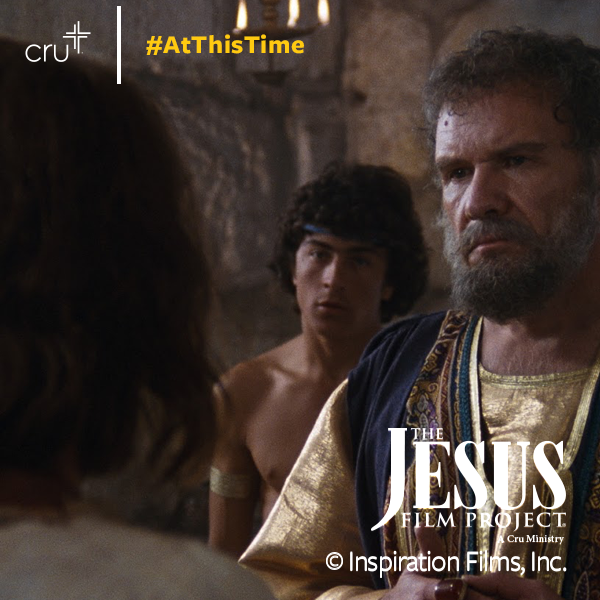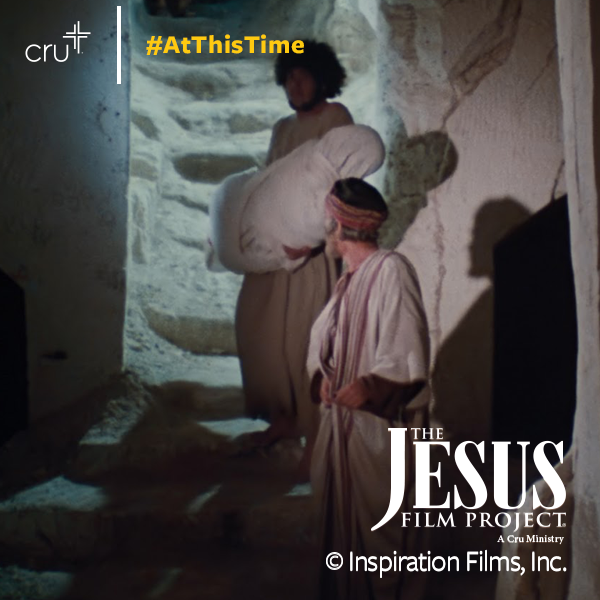Beginning March 29 through April 5, @CruTweets will be live-tweeting what Christ’s week was like in the days and hours leading up to his execution and resurrection, using the hashtag #AtThisTime on Twitter. Read the larger story from Biblical text providing context and background on what was going on from The Voice translation of the Bible.
We are posting each event in Eastern Standard Time as it reflects the exact sequence of events as if you are standing in Jerusalem.
1 - 1:30 a.m.

When Jesus finished praying, He began a brief journey with His disciples to the other side of the Kidron Valley, a deep ravine that floods in the winter rains, then farther on to a garden where He gathered His disciples.
Judas Iscariot (who had already set his betrayal in motion and knew that Jesus often met with the disciples in this olive grove) entered the garden with an entourage of Roman soldiers and officials sent by the chief priests and Pharisees.
They brandished their weapons under the light of torches and lamps. Jesus stepped forward. It was clear He was not surprised because He knew all things.
Jesus: Whom are you looking for?
Judas’s Entourage: Jesus the Nazarene.
Jesus: I am the One.
Judas, the betrayer, stood with the military force. As Jesus spoke “I am the One,” the forces fell back on the ground. Jesus asked them a second time:
Jesus: Whom are you searching for?
Judas’s Entourage: Jesus the Nazarene.
Jesus: I have already said that I am the One. If you are looking for Me, then let these men go free.
This happened to fulfill the promise He made that none of those entrusted to Him will be lost. Suddenly Peter lunged toward Malchus, one of the high priest’s servants; and with his sword, Peter severed the man’s right ear.
Jesus (to Peter): Put down your sword, and return it to the sheath. Am I to turn away from the cup the Father has given Me to drink?
So the Roman commander, soldiers, and Jewish officials arrested Jesus, cuffed His hands and feet, and brought Him to Annas (the father-in-law of Caiaphas the high priest). You may remember that Caiaphas counseled the Jews that one should die for all people.
Simon Peter and another disciple followed behind Jesus. When they arrived, Peter waited in the doorway while the other disciple was granted access because of his relationship with the high priest. That disciple spoke to the woman at the door, and Peter was allowed inside. (John 18:1-13)
2:30 a.m. - 3 a.m.
This scene has come together just so, so that the prophecies in the sacred Scripture could be fulfilled.
And at that, all the disciples ran away and abandoned Him. The crowd that had arrested Jesus took Him to Caiaphas, the high priest. The scribes and elders had gathered at Caiaphas’s house and were waiting for Jesus to be delivered. Peter followed Jesus (though at some distance so as not to be seen). He slipped into Caiaphas’s house and attached himself to a group of servants. And he sat watching, waiting to see how things would unfold.
The high priest and his council of advisors first produced false evidence against Jesus—false evidence meant to justify some charge and Jesus’ execution. But even though many men were willing to lie, the council couldn’t come up with the evidence it wanted. Finally, two men stood up.
Two Men: Look, He said, “I can destroy God’s temple and rebuild it in three days.” What more evidence do you need?
Then Caiaphas the high priest stood up and addressed Jesus.
Caiaphas: Aren’t You going to respond to these charges? What exactly are these two men accusing You of?
Jesus remained silent.
Caiaphas (to Jesus): Under a sacred oath before the living God, tell us plainly: are You the Anointed One, the Son of God?
Jesus: So you seem to be saying. I will say this: beginning now, you will see the Son of Man sitting at the right hand of God’s power and glory and coming on heavenly clouds.
The high priest tore his robes and screeched.
Caiaphas: Blasphemy! We don’t need any more witnesses—we’ve all just witnessed this most grievous blasphemy, right here and now. So, gentlemen, what’s your verdict?
Gentlemen: He deserves to die.
Then they spat in His face and hit Him. Some of them smacked Him, slapped Him across the cheeks, and jeered. (Matthew 26:56-68)
5 a.m.
Eventually the chief priests and the elders looked around and saw that it was morning. They convened a council meeting whose sole purpose was to hand down Jesus’ death sentence. They tied Jesus up, took Him away, and handed Him over to the governor of Judea, a man called Pilate. (Matthew 27:1-2)
6 a.m.

So the whole council got up and took Jesus to Pilate. They brought accusations against Him.
Sanhedrin: We have observed this man leading our nation astray. He even forbade us to pay our taxes to Caesar. He claims to be the Anointed One and a King Himself.
Pilate: Are You the King of the Jews?
Jesus: It’s as you say.
Pilate (to the chief priest and crowd): I find this man guilty of no crime.
Sanhedrin (growing more intense): He has been stirring up discontent among the people all over Judea. He started up in Galilee, and now He’s brought His brand of trouble all the way to Jerusalem!
Pilate: Just a minute. Is this man a Galilean? (Luke 23:1-6)
7 a.m.

When Pilate learned that Jesus was indeed Galilean—which meant He was officially under Herod’s jurisdiction—Pilate sent Him over to Herod, who was currently in Jerusalem. Herod was fascinated to meet Jesus for he had heard about Him for a long time. He was hoping he might be treated to a miracle or two.
He interrogated Jesus for quite a while, but Jesus remained silent, refusing to answer his questions. Meanwhile the chief priests and religious scholars had plenty to say—angrily hurling accusations at Jesus.
Eventually Herod and his soldiers began to insult Jesus, mocking and degrading Him. They put expensive clothing on Him and sent Him back to Pilate. This ended a long-standing rift between Herod and Pilate; they became friends from that day forward. (Luke 23:7-12)
7:30 - 7:45 a.m.
Pilate assembled the chief priests and other Jewish authorities.
Pilate: You presented this man to me as a rabble-rouser, but I examined Him in your presence and found Him not guilty of the charges you have leveled against Him. Herod also examined Him and released Him to my custody. So He hasn’t done anything deserving the death penalty. I’ll see to it that He is properly whipped and then let Him go.
[ It was the custom for Pilate to set one prisoner free during the holiday festivities.]
Crowd (all shouting at once): Away with this man! Free Barabbas instead!
Crucifixion is a favorite Roman punishment for insurrectionists, slaves, and prisoners of war. Anyone daring to defy the power and authority of Caesar is executed in this public and humiliating way. Jesus indeed is a revolutionary. He doesn’t come to proclaim a new religion, but a new kingdom—a new way of life. He is indeed a threat to Caesar’s way of doing things, a way that co-opts the religious leaders.
Jesus’ revolution is a peaceful revolution. He doesn’t advocate the use of violence—in fact, when one of His disciples uses the sword to try to protect Jesus from arrest, Jesus heals the “enemy” and rebukes His disciple. So Jesus doesn’t support the regime of Caesar or follow the usual violent path of revolution: He leads a revolutionary revolution—in a path of love, healing, justice, and reconciliation.
Jesus appropriates and transforms the symbol of their power into a symbol of His greater power. He makes the cross not the icon of violent domination, but the reverse. By hanging on the cross and speaking of forgiveness, Jesus shows that there is a greater power at work in the world than the power of domination: it’s the power of God’s saving and reconciling love.
Barabbas had been imprisoned after being convicted of an insurrection he had led in Jerusalem. He had also committed murder. Pilate argued with them, wishing he could release Jesus, but they wouldn’t be silenced.
Crowd (shouting): Crucify Him! Crucify Him!
Pilate (countering a third time): Why? What has He done that is so evil? I have found in Him no offense worthy of capital punishment. As I said, I will punish Him and then release Him.
But they would not relent. They shouted louder and louder that He should be crucified, and eventually Pilate capitulated. So he pronounced the punishment they demanded.
He released the rebel and murderer Barabbas—the insurrectionist they had pleaded for in His place—and he handed Jesus over to them to do with as they desired. (Luke 23:13-25)
8:30 a.m.
The governor’s soldiers took Jesus into a great hall, gathered a great crowd, and stripped Jesus of His clothes, draping Him in a bold scarlet cloak, the kind that soldiers sometimes wore. They gathered some thorny vines, wove them into a crown, and perched that crown upon His head. They stuck a reed in His right hand, and then they knelt before Him, this inside-out, upside-down King. They mocked Him with catcalls.
Soldiers: Hail, the King of the Jews!
They spat on Him and whipped Him on the head with His scepter of reeds, and when they had their fill, they pulled off the bold scarlet cloak, dressed Him in His own simple clothes, and led Him off to be crucified. (Matthew 27:27-31)
9 - 9:30 a.m.

Pilate handed Him over to his soldiers, knowing that He would be crucified. They sent Jesus out carrying His own instrument of execution, the cross, to a hill known as the Place of the Skull, or Golgotha in Hebrew. In that place, they crucified Him along with two others.
One was on His right and the other on His left. Pilate ordered that a plaque be placed above Jesus’ head. It read, “Jesus of Nazareth, the King of the Jews.” Because the site was near an urban region, it was written in three languages (Greek, Latin, and Hebrew) so that all could understand.
Chief Priests (to Pilate): Don’t write, “The King of the Jews.” Write, “He said, ‘I am King of the Jews’!”
Pilate: I have written what I have written.

As Jesus was being crucified, the soldiers tore His outer garments into four pieces, one for each of them. They wanted to do the same with His tunic, but it was seamless—one piece of fabric woven from the top down. So they said,
Soldier (to other soldiers): Don’t tear it. Let’s cast lots, and the winner will take the whole thing.
This happened in keeping with the Hebrew Scriptures, which said, “They divided My outer garments and cast lots for My clothes.”These soldiers did exactly what was foretold in the Hebrew Scriptures. Jesus’ mother was standing next to His cross along with her sister, Mary the wife of Clopas, and Mary Magdalene. Jesus looked to see His mother and the disciple He loved standing nearby. (John 19:16-26)
10 a.m.
And so they had Him crucified. They divided the clothes off His back by drawing lots, and they sat on the ground and watched Him hang. They placed a sign over His head: “This is Jesus, King of the Jews.” And then they crucified two thieves next to Him, one at His right hand and one at His left hand.
Passersby shouted curses and blasphemies at Jesus. They wagged their heads at Him and hissed.
Passersby: You’re going to destroy the temple and then rebuild it in three days? Why don’t You start with saving Yourself? Come down from the cross if You can, if You’re God’s Son.
Chief Priests, Scribes, and Elders (mocking Him): He saved others, but He can’t save Himself. If He’s really the King of Israel, then let Him climb down from the cross—then we’ll believe Him. He claimed communion with God—well, let God save Him, if He’s God’s beloved Son.
Even the thieves hanging to His right and left poured insults upon Him. (Matthew 27:35-44)
11 a.m. - Noon
Soldiers: Hey, if You’re the King of the Jews, why don’t You free Yourself!
Even the inscription they placed over Him was intended to mock Him—“This is the King of the Jews!” [This was written in Greek, Latin, and Hebrew.]
One of the criminals joined in the cruel talk.
Cynical Criminal: You’re supposed to be the Anointed One, right? Well—do it! Rescue Yourself and us!
But the other criminal told him to be quiet.
Believing Criminal: Don’t you have any fear of God at all? You’re getting the same death sentence He is! We’re getting what we deserve since we’ve committed crimes, but this man hasn’t done anything wrong at all! (turning to Jesus) Jesus, when You come into Your kingdom, please remember me.
Jesus: I promise you that this very day you will be with Me in paradise.
At this point, it was about noon, and a darkness fell over the whole region. The darkness persisted until about three in the afternoon.” (Luke 23: 37- 44)
1 - 3 p.m.
When Jesus drank, He spoke:
Jesus: It is finished!
In that moment, His head fell; and He gave up the spirit. (Matthew 27:46-50)
“In the middle of the dark afternoon, Jesus cried out in a loud voice.
Jesus: Eli, Eli, lama sabachthani—My God, My God, why have You forsaken Me?
Bystanders: He’s calling on Elijah.
One bystander grabbed a sponge, steeped it in vinegar, stuck it on a reed, and gave Jesus the vinegar to drink.
Others: We’ll see—we’ll see if Elijah is going to come and rescue Him.
And then Jesus cried out once more, loudly, and then He breathed His last breath.” (John 19:30)
3:15 p.m.
“And at some point during this darkness, the curtain in the temple was torn in two.
The tearing of this heavy curtain in the temple is highly symbolic. Because this curtain separated the holiest place in the temple from the rest of the temple, some see in this act a symbol of God opening the way for unholy humans to enter into His holy presence: Jesus’ death brought forgiveness and opened the way for all to come to God.
Others see in the curtain’s being torn the opposite meaning: God’s presence can no longer be confined to any single geographical place. The suffering and death of Jesus ended one age of human history, and now a new era has begun. Now God is on the move, at large, invading the whole world. Or perhaps this graphic image means both.
Jesus (shouting out loudly): Father, I entrust My spirit into Your hands!
And with those words, He exhaled—and breathed no more. (Luke 23:45-46)
3:20 p.m.
The Roman Centurion, the soldier in charge of the executions, stood in front of Jesus, [heard His words,] and saw the manner of His death.
Centurion: Surely this man was the Son of God! (Mark 15:39)
3:30 - 3:45 p.m
The Jews asked Pilate to have their legs broken so the bodies would not remain on the crosses on the Sabbath. It was the day of preparation for the Passover, and that year the Passover fell on the Sabbath. The soldiers came and broke the legs of both the men crucified next to Jesus. When they came up to Jesus’ cross, they could see that He was dead; so they did not break His legs. Instead, one soldier took his spear and pierced His abdomen, which brought a gush of blood and water.
This testimony is true. In fact, it is an eyewitness account; and he has reported what he saw so that you also may believe. It happened this way to fulfill the Hebrew Scriptures that “not one of His bones shall be broken”; and the Hebrew Scriptures also say, “They will look upon Him whom they pierced.” (John 19:31-37)
9 p.m.

After all this, Joseph of Arimathea, a disciple who kept his faith a secret for fear of the Jewish officials, made a request to Pilate for the body of Jesus. Pilate granted his request, and Joseph retrieved the body.
Nicodemus, who first came to Jesus under the cloak of darkness, brought over 100 pounds of myrrh and ointments for His burial. Together, they took Jesus’ body and wrapped Him in linens soaked in essential oils and spices, according to Jewish burial customs.
Near the place He was crucified, there was a garden with a newly prepared tomb. Because it was the day of preparation, they arranged to lay Jesus in this tomb so they could rest on the Sabbath. (John 19:38-42)
© GCMN - A ministry of Campus Crusade for Christ International. All Right Reserved.